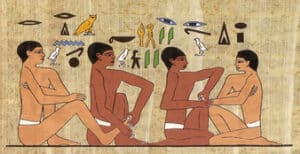We know that the early Reflexology dates back to ancient Egypt where it already practiced this therapy. The first prints were found in the tomb of a doctor and for the year 2,330 BC

In them, certain inscriptions and hieroglyphics concerning this technique, where the application of reflexology massage is clearly illustrated and displayed. In addition to the Egyptian culture, our knowledge, practiced in other cultures, such as India and China where it was perfected. In the late nineteenth century, the Anglo Doctor H. Head and Canadian JN Mackenzie, demonstrated that there was a correspondence between the reflection type foot skin surface and within the body, using this therapy for therapeutic purposes. In the early twentieth century, William Fitzgerald, an American otolaryngologist, studied the research of Dr H Bressler about the possibility of intervening in the human body.
These theories argue that certain body parts correspond with each other. Dr. Fitzgerald tested their hypothesis by anesthetizing an area of the human body and then pressured her; thus found that anesthesia is also produced in the area reflects where they had pressed. Edwin Bowers, used a more radical demonstration pricked with a needle the face of a volunteer. The jab will not cause any damage because while he was pressing a point on the hand corresponding to the area reflects the place where they had stuck with the needle on the face of the volunteer.

In 1930 Eunice Inglham conclude that from different parts of the body can access all parts of it. Therefore, it showed that there is a connection between two reflex points, allowing act more easily and effectively in those areas where the response has better therapeutic results. Eunice Inglham drew up maps of the human body and made to correspond to one or more parts of the foot. With that getting a higher therapeutic efficacy than if they worked directly on the affected area, especially when it came to reducing pain. E. Inglham is considered, by many, the forerunner of Reflexology as we know it today.
